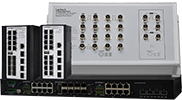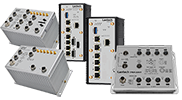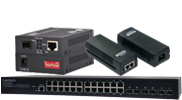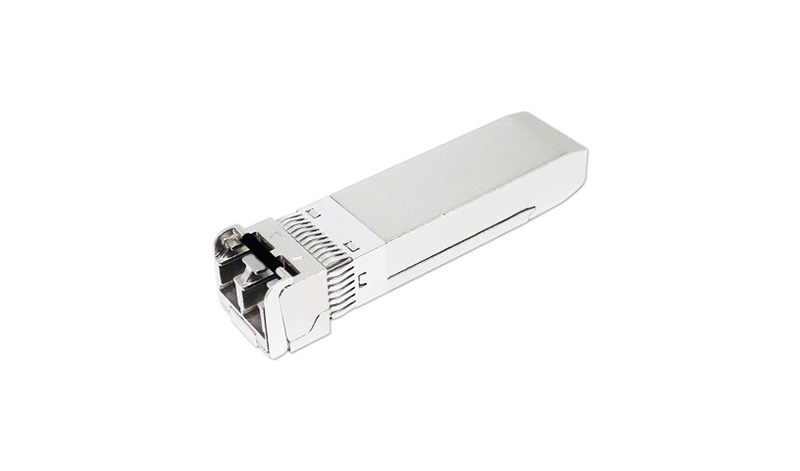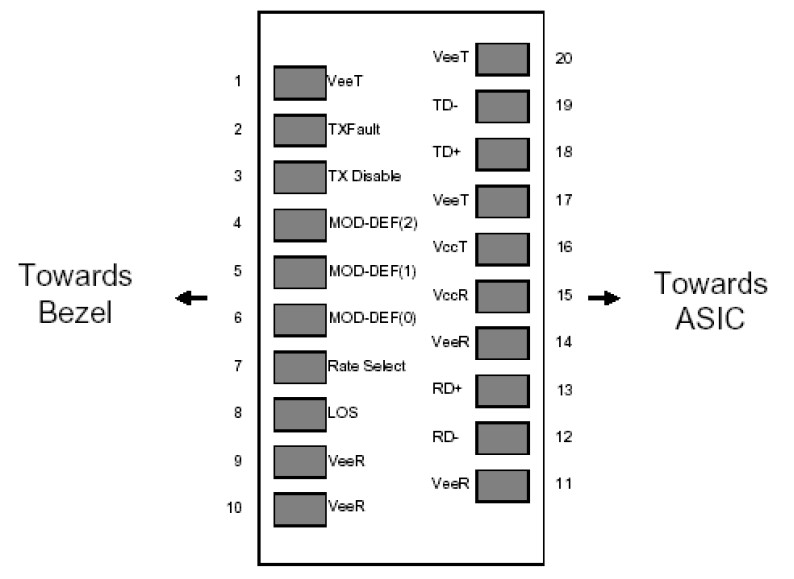10 GSFP + SR Transceiver
- Distance: 300M
- Standard Operating Temperature: -10°C ~ 70°C
- Wide Operating Temperature: -40°C ~ 85°C
OVERVIEW
Lantech 10G SFP + SR T Small Form Factor Pluggable SFP+ transceivers are compliant with the current SFP+ Multi-Source Agreement (MSA) Specification. The high performance uncooled 850nm VCSEL transmitter and high sensitivity PIN receiver provide superior performance for 10GBase-SR Ethernet applications up to 300m optical links.
FEATURES
- Compliant with IEEE802.3ae 10GBase-SR Ethernet Standard
- Compliant with SFF8472 diagnostic monitoring interface
- Compliant with SFP+ MSA
- Hot Pluggable
- 850nm VCSEL laser transmitter.
- Duplex LC connector
- 2-wire interface for management and diagnostic monitor
- Single +3.3V power supply voltages
- Transmission distance of 300m over multi mode OM3 fiber
- RoHS Compliant Part
SPECIFICATIONS
Absolute Maximum Ratings
Parameter |
Symbol |
Min. |
Max. |
Unit |
Note |
Storage Temperature |
Ts |
-40 |
+85 |
°C |
|
Operating Temperature |
Top |
0+70 |
|
°C |
|
Supply Voltage |
VccT, VccR |
-0.5 |
4.0 |
V |
|
Storage Relative Humidity |
RH |
5 |
95 |
% |
|
Recommended Operating Conditions
Parameter |
Symbol |
Min. |
Typ. |
Max. |
Unit |
Note |
Case Operating Temperature |
ToP |
0 |
- |
+70 |
°C |
|
Supply Voltage |
Vcc |
+3.15 |
+3.3 |
+3.46 |
V |
|
Supply Current |
Icc |
|
180 |
250 |
mA |
|
Transmitter Electro-Optical Characteristics
Vcc= 3.15V to 3.46V, Top = 0 C to 70 C
Parameters |
Symbol |
Min. |
Typ. |
Max. |
Unit |
Note |
||
Operating Date Rate |
DR |
|
10.3125 |
|
Gb/s |
|
||
Bit Error Rate |
BER |
|
|
10-12 |
|
|
||
Optical Launch Power |
Po |
-6.5 |
|
-1 |
dBm |
1 |
||
Optical Launch Power (OMA) |
Po-OMA |
-4.3 |
|
-2.8 |
dBm |
1 |
||
Center Wavelength |
λ |
840 |
850 |
860 |
nm |
|
||
Spectral Width (RMS) |
△λ |
0.05 |
|
0.45 |
nm |
|
||
Optical Extinction Ratio |
ER |
3.5 |
|
|
dB |
|
||
Average Launch power of OFF Transmitter |
POFF |
|
|
-30 |
dBm |
|
||
Optical Eye Mask |
|
IEEE802.3ae |
|
|||||
Relative Intensity Noise |
RIN |
|
|
-128 |
dB/Hz |
|
||
Differential data input voltage |
VDIFF |
150 |
|
1600 |
mV |
|
||
Transmit Disable Voltage |
Vdis |
2.0 |
|
Vcc |
V |
|
||
Transmit Enable Voltage |
Ven |
Vee |
|
Vee+0.8 |
V |
|
||
Note1: The optical power is launched into a 50/125μm multi-mode fiber |
||||||||
Receiver Electro-Optical Characteristics
Vcc= 3.15V to 3.46V, Top = 0 C to 70 C
Parameters |
Symbol |
Min. |
Typ. |
Max. |
Unit |
Note |
||
Operating Date Rate |
DR |
|
10.3125 |
|
Gb/s |
|
||
Receiver Sensitivity |
PIN_min |
|
|
-9.9 |
dBm |
1 |
||
Receiver Sensitivity (OMA) |
PIN_OMA |
|
|
-11.1 |
dBm |
1 |
||
Maximum Input Power |
PIN_max |
|
|
-1 |
dBm |
1 |
||
Optical Center Wavelength |
λC |
840 |
850 |
860 |
nm |
|
||
Receiver Reflectance |
RR |
|
|
-12 |
dB |
|
||
LOS De-Assert |
LOSD |
|
|
-12 |
dBm |
|
||
LOS Assert |
LOSA |
-30 |
|
|
dBm |
|
||
LOS Hysteresis |
LOSHY |
0.5 |
|
|
dB |
|
||
Differential data output voltage |
Vout,pp |
300 |
|
1000 |
mV |
|
||
Data Output Rise/Fall Time (20%~80%) |
Tr/Tf |
|
|
30 |
ps |
|
||
Receiver LOS Signal Output Voltage-Low |
LOSVL |
Vee |
|
0.5 |
V |
|
||
Receiver LOS Signal Output Voltage-High |
LOSVH |
2.4 |
|
Vcc |
V |
|
||
Note1: Measured with a PRBS 231-1 test pattern @10.3125Gbps BER<10-12 |
||||||||
Pin Assignment
|
Pin Description
Pin |
Name |
Function / Description |
1 |
VeeT |
Transmitter Ground |
2 |
TX_Fault |
Transmitter Fault Indication (1) |
3 |
TX_Disable |
Transmitter Disable – Turns off transmitter laser output (2) |
4 |
SDA |
2-wire Serial Interface Data Line (SDA: Serial Data Signal) (3) |
5 |
SCL |
2-wire Serial Interface Clock (SCL: Serial Clock Signal) (3) |
6 |
Mod_ABS |
Module Absent, connected to VeeT or VeeR in the module (3) |
7 |
RS0 |
Rate Select 0, optionally controls SFP+ module receiver (5) |
8 |
Rx_LOS |
Receiver Loss of Signal Indication (4) |
9 |
RS1 |
Rate Select 1, optionally controls SFP+ module transmitter (5) |
10 |
VeeR |
Receiver Ground |
11 |
VeeR |
Receiver Ground |
12 |
RD- |
Receiver Inverted Data output, Differential LVPECL, AC coupled |
13 |
RD+ |
Receiver Non-Inverted Data output, Differential LVPECL, AC coupled |
14 |
VeeR |
Receiver Ground |
15 |
VccR |
Receiver 3.3V Power Supply |
16 |
VccT |
Transmitter 3.3V Power Supply |
17 |
VeeT |
Transmitter Ground |
18 |
TD+ |
Transmitter Non-Inverted Data Input, Differential LVPECL, AC coupled |
19 |
TD- |
Transmitter Inverted Data Input, Differential LVPECL, AC coupled |
20 |
VeeT |
Transmitter Ground |
Note1: TX Fault is open collector/drain output which should be pulled up externally with a 4.7K~ 10KΩ resistor on the host board to supply <VccT+0.3V or VccR+0.3V. When high, this output indicates a laser fault of some kind. Low indicates normal operation. In the low state, the output will be pulled to <0.8V. |
||
Digital Diagnostic Functions
As defined by the SFP MSA (SFF-8472) Lantech’s SFP transceivers provide digital diagnostic functions via a 2-wire serial interface, which allows real-time access to the following operating parameters:
- Transceiver temperature
- Laser bias current
- Transmitted optical power
- Received optical power
- Transceiver supply voltage
It also provides a sophisticated system of alarm and warning flags, which may be used to alert end-users when particular operating parameters are outside of a factory-set normal range.
The operating and diagnostics information is monitored and reported by a Digital Diagnostics Controller (DDC) inside the transceiver, which is accessed through the 2-wire serial interface. When the serial protocol is activated, the serial clock signal (SCL pin) is generated by the host. The positive edge clocks data into the SFP transceiver into those segments of its memory map that are not write-protected. The negative edge clocks data from the SFP transceiver. The serial data signal (SDA pin) is bi-directional for serial data transfer. The host uses SDA in conjunction with SCL to mark the start and end of serial protocol activation. The memories are organized as a series of 8-bit data words that can be addressed individually or sequentially.
Digital Diagnostic Memory Map
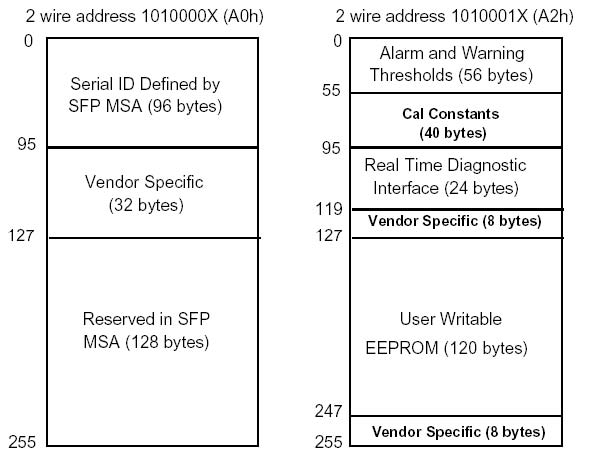
Digital Diagnostic Monitoring Characteristics Map
Parameter |
Accuracy |
Unit |
Note |
Temperature |
±3 |
℃ |
|
Supply Voltage |
±0.1 |
V |
|
TX Bias Current |
±5 |
mA |
|
TX Output Power |
±3 |
dB |
|
RX Received Optical Power |
±3 |
dB |
|
DIMENSION
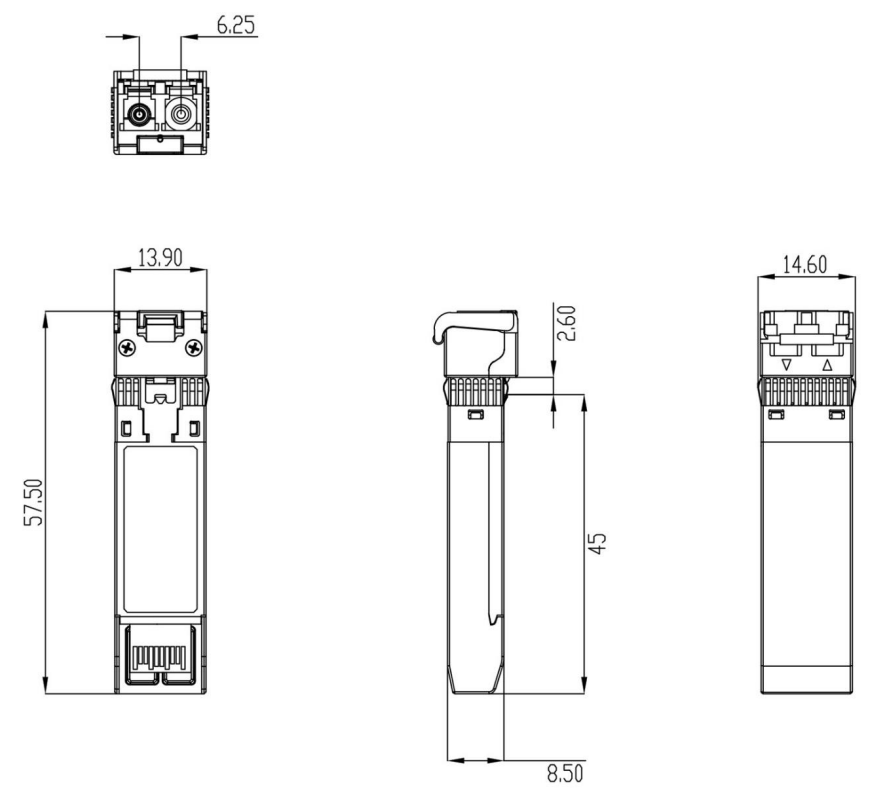 *All dimensions are ±0.2mm unless otherwise specified
*All dimensions are ±0.2mm unless otherwise specified
ORDERING INFORMATION
Part Number |
TX |
RX |
Link |
DDM |
Mode |
Temp. |
8330-193D-V1 |
850nm |
850nm |
OM3:300m |
YES |
Multi-mode |
-10~70°C |
8330-193DE-V1 |
850nm |
850nm |
OM3:300m |
YES |
Multi-mode |
-40~85°C |

